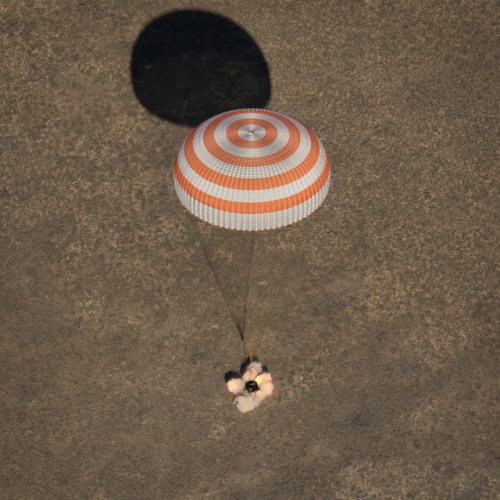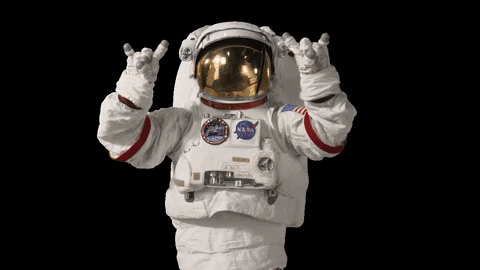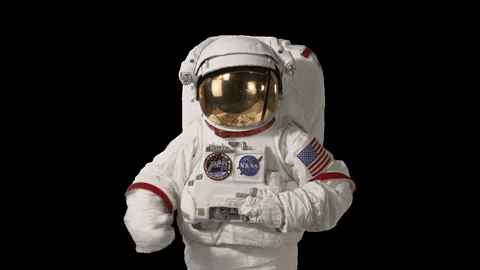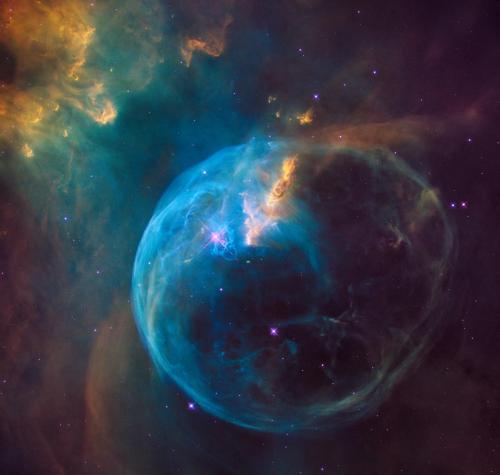Experience How Microgravity Affects The Human Body
Experience How Microgravity Affects the Human Body
Now is your chance to experience what it’s like to live and work on the International Space Station! The new NASA Science: Humans in Space app will let you explore the station while virtually experiencing what it does to your body.

Life in space is no float in the park. Astronauts contend with everything from motion sickness to face swelling to loss of bone density. That’s why many research investigations on the space station study how humans can better adapt to microgravity both in Earth's orbit as well as on longer missions to the Moon and Mars.

Deal with these challenges and perform crucial daily workouts as you explore the orbiting laboratory and ensure the H-II Transfer Vehicle successfully berths to the station.

You can even collect mission patches along the way for completing tasks, counteracting the effects of microgravity and making discoveries.

Download the application for Android here and iPhone here. Find more NASA apps here.
Want to learn about more investigations heading to the space station (or even ones currently under way)? Make sure to follow @ISS_Research on Twitter and Space Station Research and Technology News on Facebook.
Make sure to follow us on Tumblr for your regular dose of space: http://nasa.tumblr.com.
More Posts from Nasa and Others
A View into the Past

Our Hubble Space Telescope just found the farthest individual star ever seen to date!
Nicknamed “Earendel” (“morning star” in Old English), this star existed within the first billion years after the universe’s birth in the big bang. Earendel is so far away from Earth that its light has taken 12.9 billion years to reach us, far eclipsing the previous single-star record holder whose light took 9 billion years to reach us.
Though Earendel is at least 50 times the mass of our Sun and millions of times as bright, we’d normally be unable to see it from Earth. However, the mass of a huge galaxy cluster between us and Earendel has created a powerful natural magnifying glass. Astronomers expect that the star will be highly magnified for years.
Earendel will be observed by NASA’s James Webb Space Telescope. Webb's high sensitivity to infrared light is needed to learn more about this star, because its light is stretched to longer infrared wavelengths due to the universe's expansion.
The International Space Station: Apex of International Collaboration
It's National Space Day! To mark the occasion, we're reflecting on the International Space Station, which has been continuously occupied since Nov. 2, 2000. As our orbiting laboratory that enables us to conduct important science off our home planet, the ISS allows researchers from all over the world to put their talents to work on innovative experiments in the microgravity environment. An international partnership of space agencies provides and operates the elements of the ISS. The principals are the space agencies of the United States, Russia, Europe, Japan and Canada. Although each space station partner has distinct agency goals for station research, each partner shares a unified goal to extend the resulting knowledge for the betterment of humanity! Here are 5 fun facts about our about our out-of-this world floating laboratory:
1. The ISS is a unique scientific platform that has enabled more than 3,600 researchers in 106 countries and areas to conduct more than 2,500 experiments in microgravity through February 2018—and the research continues.
2. Astronauts and cosmonauts have conducted more than 205 spacewalks (and counting!) for space station construction, maintenance and repair since December 1998.

3. The station’s orbital path takes it over 90 percent of the Earth’s population, with astronauts taking millions of images of the planet below.
4. Six spaceships can be connected to the space station at once.

5. An international crew of at most six people live and work while traveling at a speed of five miles per second, orbiting Earth about every 90 minutes.
Currently, six humans are living and working on the International Space Station, which orbits 250 miles above our planet at 17,500mph.
Make sure to follow us on Tumblr for your regular dose of space: http://nasa.tumblr.com.

Touchdown!
A Soyuz spacecraft is seen as it lands with astronaut Shane Kimbrough of NASA and Russian Flight Engineers Sergey Ryzhikov and Andrey Borisenko near the town of Zhezkazgan, Kazakhstan on Monday, April 10. Kimbrough, Ryzhikov, and Borisenko are returning after 173 days in space onboard the International Space Station.
While living and working aboard the space station, the crew members contributed to hundreds of experiments in biology, biotechnology, physical science and Earth science aboard the world-class orbiting laboratory. For example, the Microgravity Expanded Stem Cells investigation had crew members observe cell growth and other characteristics in microgravity.
Results from this investigation could lead to the treatment of diseases and injury in space, and provide a way to improve stem cell production for medical therapies on Earth. Photo Credit: (NASA/Bill Ingalls)
Make sure to follow us on Tumblr for your regular dose of space: http://nasa.tumblr.com

Clouds swirling in the coffee colored atmosphere of Jupiter, looks more like a familiar morning beverage of champions.
This image from our Juno spacecraft was captured in North North Temperate Belt. Image Credit: Enhanced Image by Gerald Eichstädt and Sean Doran (CC BY-NC-SA)/NASA/JPL-Caltech/SwRI/MSSS
Make sure to follow us on Tumblr for your regular dose of space: http://nasa.tumblr.com
Sing About NASA with Our Interns
Each semester, interns at Johnson Space Center (JSC) have the opportunity to contribute to our agency’s missions and help us lead the frontier of human space exploration. Interns at JSC also have the opportunity to enhance their experience through weekly meetings to discuss social and professional development topics, and can also get involved in many different committees.
The intern video committee from each semester comes up with ideas and carries out the entire process of creating a video that puts a creative, youthful spin on spreading NASA messages.
Here are a few highlights from some of the great intern videos that have been created:
Welcome to NASA
“Welcome to NASA” is based off of Flo Rida’s “My House” and was created to raise interest for our Journey to Mars. The lyrics and scenes in the video have been re-imagined in order to inform the public about the amazing work going on at NASA and the Johnson Space Center.
Created in 2016
NASA is Good
This latest intern video is based off of Andy Grammer’s “Honey, I’m Good”. This video is designed as an outreach video to raise interest around the One-Year Mission aboard the International Space Station and the Pathways and Student Intern opportunities.
Created in 2015
NASA Johnson Style
NASA Johnson Style was created as an educational parody of Psy’s "Gangnam Style". The intent of the video is to inform the public about the work being done at Johnson Space Center and throughout the agency.
Created in 2012
I.S.S. Baby
A group of NASA interns collaborated to create the I.S.S Baby video based off of Vanilla Ice’s “Ice, Ice, Baby”. The video was designed as an outreach video to raise interest around the International Space Station.
Created in 2008
There are plenty more JSC intern videos. You can watch more and learn about the work done at JSC and throughout the agency HERE.
Make sure to follow us on Tumblr for your regular dose of space: http://nasa.tumblr.com
Tune in, Starliner! How NASA’s Near Space Network Powers Communications

On May 19, 2022, our partners at Boeing launched their Starliner CST-100 spacecraft to the International Space Station as a part of our Commercial Crew Program. This latest test puts the company one step closer to joining the SpaceX Crew Dragon in ferrying astronauts to and from the orbiting laboratory. We livestreamed the launch and docking at the International Space Station, but how? Let’s look at the communications and navigation infrastructure that makes these missions possible.

Primary voice and data communications are handled by our constellation of Tracking and Data Relay Satellites (TDRS), part of our Near Space Network. These spacecraft relay communications between the crewed vehicles and mission controllers across the country via terrestrial connections with TDRS ground stations in Las Cruces, New Mexico, and Guam, a U.S. territory in the Pacific Ocean.
TDRS, as the primary communications provider for the space station, is central to the services provided to Commercial Crew vehicles. All spacecraft visiting the orbiting laboratory need TDRS services to successfully complete their missions.

During launches, human spaceflight mission managers ensure that Commercial Crew missions receive all the TDRS services they need from the Near Space Operations Control Center at our Goddard Space Flight Center in Greenbelt, Maryland. There, communications engineers synthesize network components into comprehensive and seamless services for spacecraft as they launch, dock, undock, and deorbit from the space station.

Nearby, at our Flight Dynamics Facility, navigation engineers track the spacecraft on their ascent, leveraging years of experience supporting the navigation needs of crewed missions. Using tracking data sent to our Johnson Space Center in Houston and relayed to Goddard, these engineers ensure astronaut safety throughout the vehicles’ journey to the space station.
Additionally, our Search and Rescue office monitors emergency beacons on Commercial Crew vehicles from their lab at Goddard. In the unlikely event of a launch abort, the international satellite-aided search and rescue network will be able to track and locate these beacons, helping rescue professionals to return the astronauts safely. For this specific uncrewed mission, the search and rescue system onboard the Boeing Starliner will not be activated until after landing for ground testing.

To learn more about NASA’s Space Communications and Navigation (SCaN) services and technologies, visit https://www.nasa.gov/directorates/heo/scan/index.html. To learn more about NASA’s Near Space Network, visit https://esc.gsfc.nasa.gov/projects/NSN.
Make sure to follow us on Tumblr for your regular dose of space!
To the Moon and Beyond: Why Our SLS Rocket Is Designed for Deep Space
It will take incredible power to send the first woman and the next man to the Moon’s South Pole by 2024. That’s where America’s Space Launch System (SLS) rocket comes in to play.

Providing more payload mass, volume capability and energy to speed missions through deep space than any other rocket, our SLS rocket, along with our lunar Gateway and Orion spacecraft, creates the backbone for our deep space exploration and Artemis lunar mission goals.
Here’s why our SLS rocket is a deep space rocket like no other:
It’s a heavy lifter

The Artemis missions will send humans 280,000 miles away from Earth. That’s 1,000 times farther into space than the International Space Station. To accomplish that mega feat, you need a rocket that’s designed to lift — and lift heavy. With help from a dynamic core stage — the largest stage we have ever built — the 5.75-million-pound SLS rocket can propel itself off the Earth. This includes the 57,000 pounds of cargo that will go to the Moon. To accomplish this, SLS will produce 15% more thrust at launch and during ascent than the Saturn V did for the Apollo Program.
We have the power

Where do our rocket’s lift and thrust capabilities come from? If you take a peek under our powerful rocket’s hood, so to speak, you’ll find a core stage with four RS-25 engines that produce more than 2 million pounds of thrust alongside two solid rocket boosters that each provide another 3.6 million pounds of thrust power. It’s a bold design. Together, they provide an incredible 8.8 million pounds of thrust to power the Artemis missions off the Earth. The engines and boosters are modified heritage hardware from the Space Shuttle Program, ensuring high performance and reliability to drive our deep space missions.
A rocket with style

While our rocket’s core stage design will remain basically the same for each of the Artemis missions, the SLS rocket’s upper stage evolves to open new possibilities for payloads and even robotic scientific missions to worlds farther away than the Moon like Mars, Saturn and Jupiter. For the first three Artemis missions, our SLS rocket uses an interim cryogenic propulsion stage with one RL10 engine to send Orion to the lunar south pole. For Artemis missions following the initial 2024 Moon landing, our SLS rocket will have an exploration upper stage with bigger fuel tanks and four RL10 engines so that Orion, up to four astronauts and larger cargoes can be sent to the Moon, too. Additional core stages and upper stages will support either crewed Artemis missions, science missions or cargo missions for a sustained presence in deep space.
It’s just the beginning

Crews at our Michoud Assembly Facility in New Orleans are in the final phases of assembling the core stage for Artemis I— and are already working on assembly for Artemis II.
Through the Artemis program, we aim not just to return humans to the Moon, but to create a sustainable presence there as well. While there, astronauts will learn to use the Moon’s natural resources and harness our newfound knowledge to prepare for the horizon goal: humans on Mars.
Make sure to follow us on Tumblr for your regular dose of space: http://nasa.tumblr.com

Guy Bluford Changed the Course of Space History
On Aug. 30, 1983, Guion Bluford, better known as Guy, became the first African American to fly to space. An accomplished jet pilot and aerospace engineer, Bluford became part of NASA’s 1978 astronaut class that included the first African American, the first Asian American, and the first women astronauts.
He and the other crew members of mission STS-8 were aboard the orbiter Challenger as it lifted off from Kennedy Space Center in Florida; it was the first nighttime launch and landing of the Space Shuttle program. While aboard, he and the other crew members deployed the Indian National Satellite (INSAT-1B), operated a Canadian-built robot arm, conducted experiments with live cell samples, and participated in studies measuring the effects of spaceflight on humans.
Guy Bluford chased his childhood dream of becoming an aerospace engineer, and in doing so, changed history and encouraged other Black astronauts to follow in his footsteps.
Make sure to follow us on Tumblr for your regular dose of space—and for milestones like this!
Take Your GIF Game to Cosmic Levels & React Like a NASA Astronaut!
We partnered with GIPHY to help take your GIF game to cosmic levelssss. As the Artemis generation who will witness a whole new era of space travel, we wanted make sure you could express yourself... like an astronaut!
So, if you want to show some love...

... or you’re pumped we’re half way to Friday ...

We’ve got you covered.

Don’t miss our whole collection of astronaut reactions!

Want to use them on your device?

Type ‘NASAReaction’ in your device’s GIPHY keyboard...

.... and choose your favorite!

You can access our full collection of official NASA astronaut GIFs by visiting: https://giphy.com/nasa/reaction-pack
Make sure to follow us on Tumblr for your regular dose of space: http://nasa.tumblr.com
-
 painterofhorizons reblogged this · 1 year ago
painterofhorizons reblogged this · 1 year ago -
 luckilyblog liked this · 3 years ago
luckilyblog liked this · 3 years ago -
 00000000000000009999 liked this · 4 years ago
00000000000000009999 liked this · 4 years ago -
 lionesshathor reblogged this · 4 years ago
lionesshathor reblogged this · 4 years ago -
 lionesshathor reblogged this · 4 years ago
lionesshathor reblogged this · 4 years ago -
 somsdrc reblogged this · 5 years ago
somsdrc reblogged this · 5 years ago -
 lunaticstv reblogged this · 5 years ago
lunaticstv reblogged this · 5 years ago -
 plastilinafu liked this · 5 years ago
plastilinafu liked this · 5 years ago -
 spacetimewithstuartgary reblogged this · 5 years ago
spacetimewithstuartgary reblogged this · 5 years ago -
 wefreyame liked this · 5 years ago
wefreyame liked this · 5 years ago -
 justanordinaryhumanbeing liked this · 5 years ago
justanordinaryhumanbeing liked this · 5 years ago -
 andromeda1023 reblogged this · 5 years ago
andromeda1023 reblogged this · 5 years ago -
 fellowitch liked this · 5 years ago
fellowitch liked this · 5 years ago -
 masked-fox-creations reblogged this · 5 years ago
masked-fox-creations reblogged this · 5 years ago -
 herr-turtur liked this · 5 years ago
herr-turtur liked this · 5 years ago -
 dianabellolove liked this · 5 years ago
dianabellolove liked this · 5 years ago -
 4atruzecisi2oi liked this · 5 years ago
4atruzecisi2oi liked this · 5 years ago -
 terminalwelocity liked this · 5 years ago
terminalwelocity liked this · 5 years ago -
 surlymccoy reblogged this · 5 years ago
surlymccoy reblogged this · 5 years ago -
 bad-angela reblogged this · 5 years ago
bad-angela reblogged this · 5 years ago -
 kimbermcleod reblogged this · 5 years ago
kimbermcleod reblogged this · 5 years ago -
 boopusdeloopus liked this · 5 years ago
boopusdeloopus liked this · 5 years ago -
 believe-in-yoursleft liked this · 5 years ago
believe-in-yoursleft liked this · 5 years ago -
 chuck3337100 liked this · 5 years ago
chuck3337100 liked this · 5 years ago -
 ghostess-with-the-mostess liked this · 5 years ago
ghostess-with-the-mostess liked this · 5 years ago -
 angel-no-crux liked this · 5 years ago
angel-no-crux liked this · 5 years ago -
 overlordraax reblogged this · 5 years ago
overlordraax reblogged this · 5 years ago -
 yatzuaka reblogged this · 5 years ago
yatzuaka reblogged this · 5 years ago -
 joshlovesbacon liked this · 5 years ago
joshlovesbacon liked this · 5 years ago -
 danny7-2 liked this · 5 years ago
danny7-2 liked this · 5 years ago -
 delightfulpaperpost liked this · 5 years ago
delightfulpaperpost liked this · 5 years ago -
 cynicalwindmill liked this · 5 years ago
cynicalwindmill liked this · 5 years ago -
 randyranks reblogged this · 5 years ago
randyranks reblogged this · 5 years ago -
 randyranks liked this · 5 years ago
randyranks liked this · 5 years ago -
 moraine-moraine liked this · 5 years ago
moraine-moraine liked this · 5 years ago -
 something-creatives liked this · 5 years ago
something-creatives liked this · 5 years ago -
 tyyiyi liked this · 5 years ago
tyyiyi liked this · 5 years ago -
 librariansheart reblogged this · 5 years ago
librariansheart reblogged this · 5 years ago -
 den1990 reblogged this · 5 years ago
den1990 reblogged this · 5 years ago -
 tenacioustheoristnightmare liked this · 5 years ago
tenacioustheoristnightmare liked this · 5 years ago
Explore the universe and discover our home planet with the official NASA Tumblr account
1K posts
